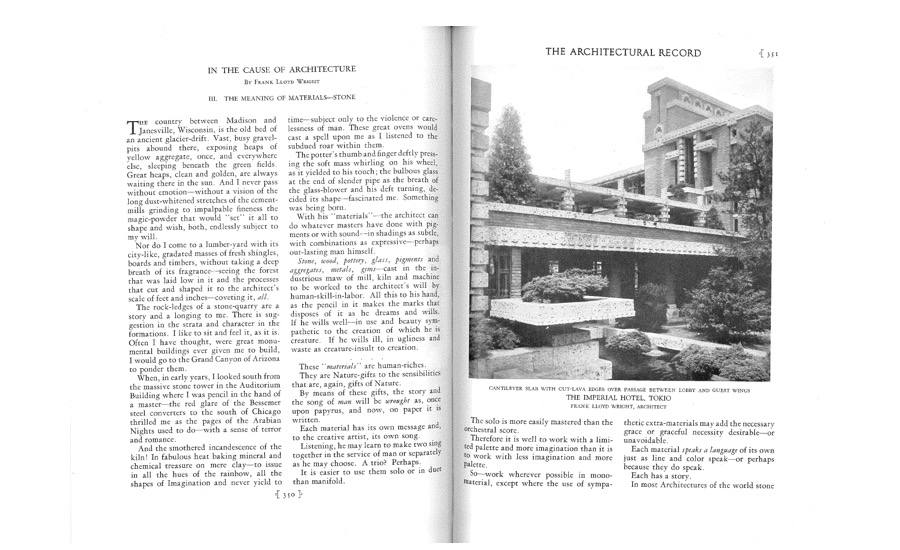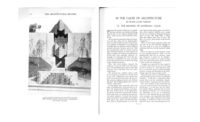THE STORY OF STONE
Stone, as a building material, as human hands begin upon it – stonecraft – becomes a shapely block.
The block is necessarily true to square and level, so that one block may securely rest upon another block and great weight be carried to greater height.
We refer to such masses, so made, as masonry.
The stone may show a natural face in the wall, or a face characteristic of the tool used to shape it – or be flatly smoothed. Sometimes honed or polished.
The walls take on the character of the surface left by the mason’s use of his tools.
The character of the wall-surface will be determined also by the kind of stone, by the kind of mason, the kind of architect. Probably by the kind of building. But, most of all, by the nature of the stone itself if the work is good stone-work.
Stone has every texture, every color and - as in marble – also exquisite line combined with both – intensified clear down the scale until we arrive at what we call “precious” stone – and then on to jewels.
But most building stone – as Caen-stone, say – is a clear negative substance, like a sheet of soft beautiful paper, no which it is appropriate to cut images, by wasting away the surfaces to sink or raise traces of the imagination like a kind of human writing, carrying the ideology of the human-race down the ages from the primitive to the decadent.
Other stone is hard and glittering, hard to cut. By rubbing away at it with other stones the surface may be made to yield a brilliant surface, finally polished until its inner nature may be seen as though looked into, as in a glass – transparent.
Most marble is of this character. And granite. The very nature of the material itself becomes its own decoration.
To cave or beat its surface, then, is a pity – if no crime.
Stones themselves have special picturesque qualities and were much cherished for their “qualities” in china and Japan. Perhaps these Orientals love stones for their own sake more than any other people. They seem to see in them the universe – at least the earth-creation, in little – and they study them with real pleasure and true appreciation.
The Byzantine mosaics of colored stone are a cherishing of these qualities, too. These mosaics on a large scale gave beautiful stone results – fine stone-work – good masonry.
But stone is a solid material, heavy, durable and most grateful for masses. A “massive” material we say, so most appropriate and effective in simple architectural masses, the nobler the better.
The Mayas used stone most sympathetically with its nature and the character of their environment. Their desecration was mostly stone-built. And when they carved it the effect resembled naturally enriched stone surfaces such as are often seen in the landscape.
The Egyptians used stone – as the Chinese used stones – with real love and understanding.
The Greeks abused stone shamefully – did not understand its nature at all except as something to be painted or gilded out of existence. Before they painted it, they fluted and rolled and molded it as though it were wood – or degraded it far lower.
Polished sophistication is not at home with stone.
The roman architects had no feeling about stone whatever. Their engineers did have – but there were few large stones.
They cut these prizes into wooden cornices to please the architects, and invented the arch to get along with small stones for construction.
The Goths made most of stone. But stone became for the Gothic imagination a mere negative material which they employed supremely well in a structural sense.
Stonecraft rose highest in the Gothic era.
But they, then, set to work and carved the beautiful construction elaborately and constructed carving in the spirit of the construction to an extent never before seen I the world. No arris was left without its moulding. It was as though stone blossomed into a thing of the human-spirit.
As though a wave of creative-impulse had seized stone and, mutable as the sea, it had heaved and swelled and broken into lines of surge, peaks of foam – human-symbols, images of organic life caught and held in its cosmic urge – a splendid song!
The song of stone?
No – because stone was used as a negative material neither limitations respected nor stone nature interpreted. In wood the result was pretty much the same as in iron or in plaster, in the hands of the Goths.
But as building-material it was scientifically used. And such stone was usually chosen as had little say for itself and so not outraged much by such cutting to the shapes of organic live – as it was subjected to, by them.
We may say the stone was not outraged – but neither was it allowed to sing its own song – to be itself. Always nearer that, by them, than anywhere else since archaic times.
But it was not the stone that inspired the Cathedrals of the Middle Ages nor invited them. It limited them.
Had it not been so – what would they have been like? Was Gothic Architecture because of stone or regardless of it?
But that is going far afield for subtle matter, and casting the shadow of doubt upon one of the most beautiful spectacles of the triumph of the human spirit over matter.








Post a comment to this article
Report Abusive Comment